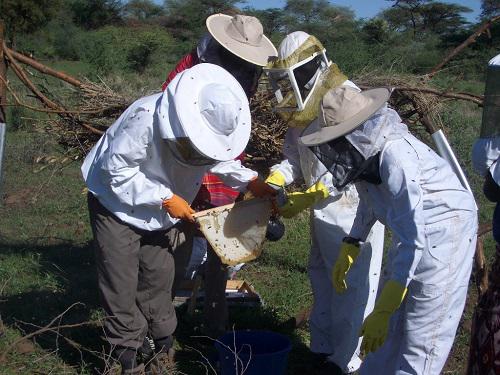Lucy King
This study investigates a unique but simple design for a beehive fence aimed to deter crop-raiding elephants from entering small scale farms and to help enhance livelihoods through the sale of honey and bee products.

While elephants are major economic assets in generating tourist revenue, crop raiding by elephants is a cause of increasing levels of conflict between local people and wildlife management strategies across Africa. Unless a cost-effective method of limiting crop damage is found, the pressure on wildlife managers to implement radical methods (such as culling) may become a reality. Conventional methods for keeping elephants away from crops use mostly fortified boundaries, typically electric fences. However these are expensive, difficult to maintain and have met with only limited success. Research now needs to focus on alternative, low cost deterrent methods that can be managed and implemented by the farmers themselves.
Previous research by Douglas-Hamilton & Vollrath (2002) and King et al. (2007) has shown that elephants both avoid trees with beehives in and run from the sound of disturbed bees. These behavioural discoveries have lead to us to question if using African bees may be a more applicable alternative as a natural elephant deterrent that also provides economic long-term benefits. The concept includes a livelihoods development element through the additional sale of honey and bee products, often managed by women in a community. If bees can deter even a small proportion of elephants from their crop-raiding activities the farmers will benefit by a doubly-increased income from saved crops and honey. This research project aims to understand what proportion of elephants will be deterred by bees and the best methods to implement such a deterrent. The project forms a key element for Lucy King’s DPhil research thesis and is the result of a joint collaboration between Save the Elephants, Kenya (www.savetheelephants.org), and the Department of Zoology, University of Oxford, UK.
A successful, but small, pilot project in 2007 tried out a unique but simple design for a “beehive fence” around one badly crop-raided farm in a high human-elephant conflict zone in Laikipia district. I compared the impact of the beehive fence to a control farm 500m away and the results have been so positive that I am starting a large-scale field trial of this beehive fence to see if the effect can be replicated amongst several farms. The project funded by Rufford Small Grants Foundation will focus on a large-scale field trial of the beehive fence design as a potential elephant deterrent around low-income farms in Kenya.